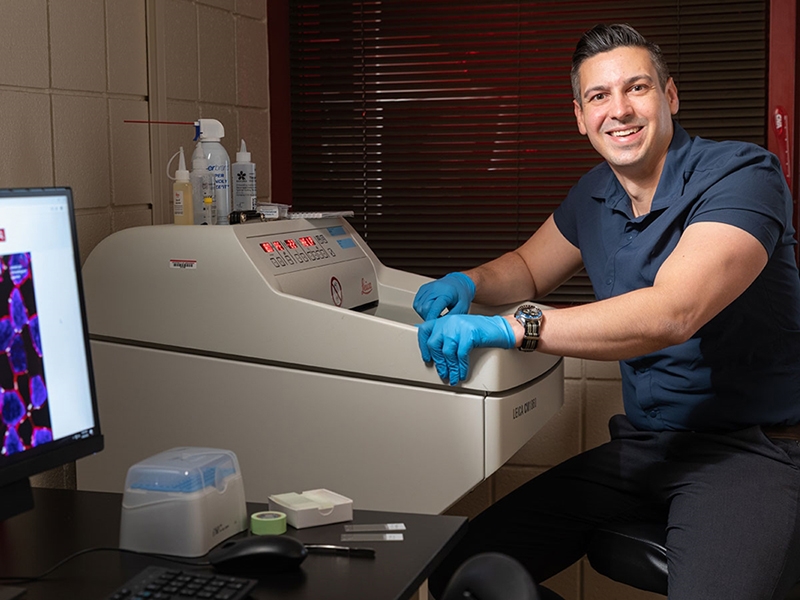NIH Awards $2.5 Million to Study Mediators of Muscle Renewal as Aging Continues
FAYETTEVILLE, Ark. – The National Institutes of Health awarded a little more than $2.5 million to researchers at the University of Arkansas to study how exercise can mitigate the decline of tissue function with aging. Kevin Murach, an assistant professor in the College of Education and Health Professions, will serve as the principal investigator.
It's well established that tissue function declines with age, but exercise can play an important role in slowing the decline of skeletal muscle, the most voluminous tissue in the body. Less well understood is to what degree exercise mitigates that decline and what is actually happening in the muscles on a molecular level.
Murach’s investigation will focus on the role of a transcription factor known as MYC. This protein is one of the four Yamanaka factors (identified as OCT3/4, SOX2, KLF4, and MYC) that can revert highly specified cells (such as a skin cell) back to a stem cell, which is a younger and more adaptable state.
In the correct dosages, inducing the Yamanaka factors throughout the body in rodents can ameliorate some hallmarks of aging in part by mimicking the adaptability that is common to more youthful cells. Of the four factors, MYC is the only one that can be induced by exercising skeletal muscle (as opposed to gene-editing to induce gene expression), but MYC also becomes less responsive to exercise with advancing age.
The NIH grant will allow Murach to continue investigating the role that MYC plays in the functional, metabolic, cellular and molecular plasticity of skeletal muscle throughout the entire lifespan. He hypothesizes that MYC induction in muscle will mimic functional and cellular aspects of exercise adaptation throughout the lifespan and amplify the effects of exercise training. MYC will mediate youthfulness at several molecular levels, including biological aging determined by a DNA methylation “clock” age, which is a way of identifying cellular aging through known markers.
“We’re really focused on this one transcription factor [MYC] that's exercise responsive,” Murach explained, “and we're going to manipulate it in different conditions throughout the aging process to see if we can make old muscle appear young again, but also doing so in combination with exercise.”
He added that “this is all in mouse models, but we have evidence from humans that this factor in muscle goes up as well with exercise, but it tends to go up less in aged muscle. And so we think that if we can drive it, we can basically ‘rejuvenate’ muscle and try to get older muscle to appear young again.”
Murach expects that their innovative approaches will serve as a foundation for understanding skeletal muscle mass regulation with aging, and provide new directions for exploring what mediates the age-defying effects of exercise.
Professor Nicholas Greene, director of the Exercise Science Research Center, will serve as a co-investigator, as will Wen-Juo Lo, an associate professor of educational statistics and research methods. Kyle Quinn, an associate professor of biomedical engineering who runs the Arkansas Integrative Metabolic Research Center, will provide additional support and resources.
About the University of Arkansas: As Arkansas' flagship institution, the U of A provides an internationally competitive education in more than 200 academic programs. Founded in 1871, the U of A contributes more than $2.2 billion to Arkansas’ economy through the teaching of new knowledge and skills, entrepreneurship and job development, discovery through research and creative activity while also providing training for professional disciplines. The Carnegie Foundation classifies the U of A among the few U.S. colleges and universities with the highest level of research activity. U.S. News & World Report ranks the U of A among the top public universities in the nation. See how the U of A works to build a better world at Arkansas Research and Economic Development News.
Topics
Contacts
Kevin A. Murach, assistant professor
Department of Health, Human Performance and Recreation
479-575-2858,
kmurach@uark.edu
Hardin Young, assistant director of research communications
University Relations
479-575-6850,
hyoung@uark.edu
Headlines
PetSmart CEO J.K. Symancyk to Speak at Walton College Commencement
J.K. Symancyk is an alumnus of the Sam M. Walton College of Business and serves on the Dean’s Executive Advisory Board.
Faulkner Center, Arkansas PBS Partner to Screen Documentary 'Gospel'
The Faulkner Performing Arts Center will host a screening of Gospel, a documentary exploring the origin of Black spirituality through sermon and song, in partnership with Arkansas PBS at 7:30 p.m. Thursday, May 2.
UAPD Officers Mills and Edwards Honored With New Roles
Veterans of the U of A Police Department, Matt Mills has been promoted to assistant chief, and Crandall Edwards has been promoted to administrative captain.
Community Design Center's Greenway Urbanism Project Wins LIV Hospitality Design Award
"Greenway Urbanism" is one of six urban strategies proposed under the Framework Plan for Cherokee Village, a project that received funding through an Our Town grant from the National Endowment for the Arts.
Spring Bike Drive Refurbishes Old Bikes for New Students
All donated bikes will be given to Pedal It Forward, a local nonprofit that will refurbish your bike and return it to the U of A campus to be gifted to a student in need. Hundreds of students have already benefited.





